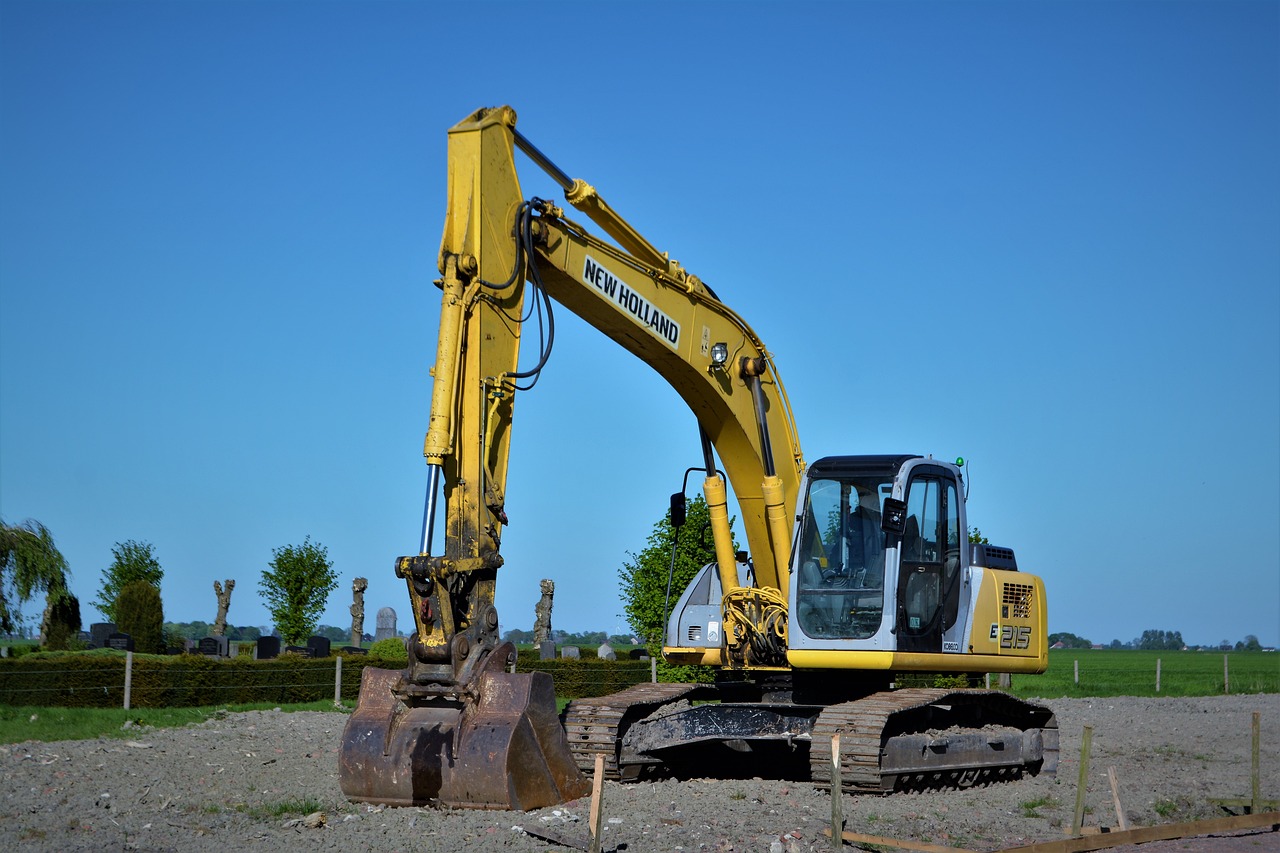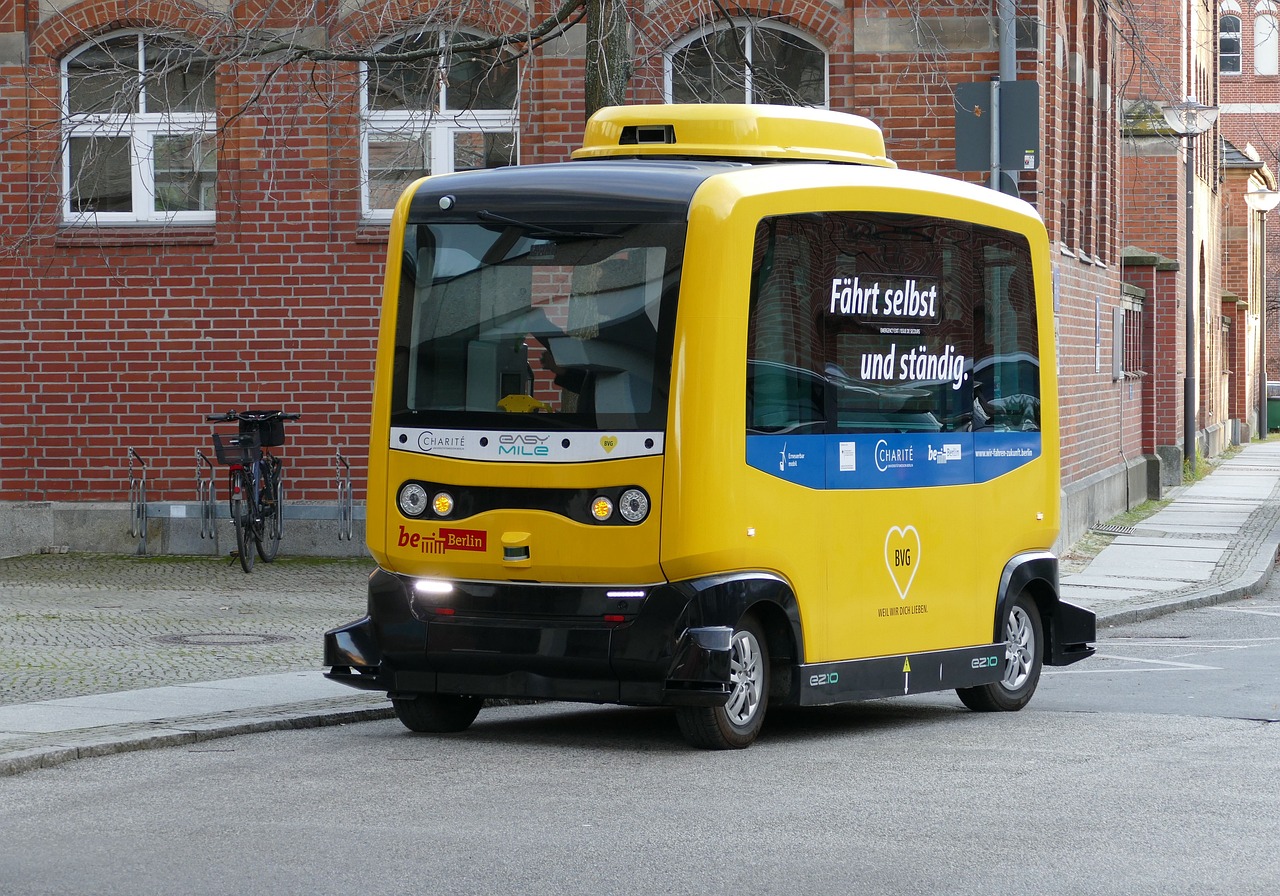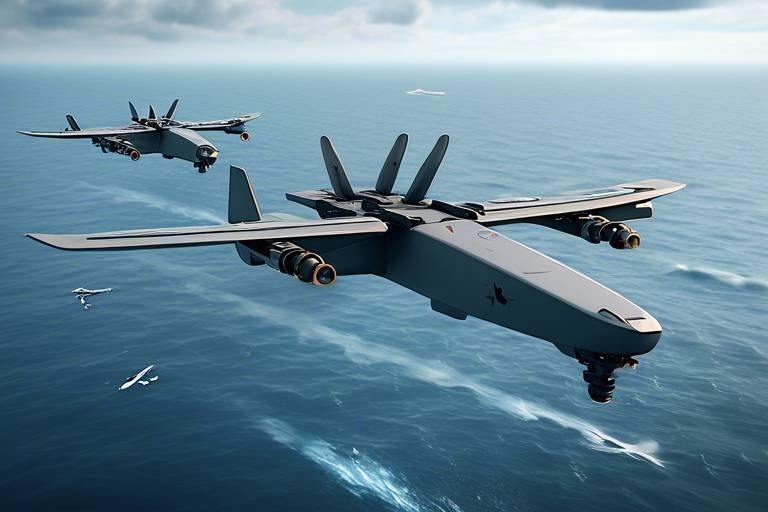Autonomous Convoys - Enhancing Military Logistics
In today’s fast-paced world, the military logistics landscape is undergoing a seismic shift, driven by the advent of autonomous convoys. Imagine a fleet of unmanned vehicles, navigating treacherous terrains, delivering supplies to troops without a single human hand on the wheel. This isn't science fiction; it's happening now. Autonomous convoys are not just a technological marvel; they represent a fundamental change in how military operations are conducted, enhancing efficiency, boosting safety, and improving operational readiness.
The integration of cutting-edge technologies such as artificial intelligence (AI), advanced sensors, and robust communication systems enables these convoys to make real-time decisions in complex environments. Think of them as a well-coordinated team of robots, working seamlessly together to ensure that critical supplies reach their destination on time. This level of automation not only minimizes human error but also allows military personnel to focus on more strategic tasks, enhancing overall mission effectiveness.
But what does this mean for the future of military logistics? It signifies a transformation where costs can be reduced, risks to personnel can be minimized, and the speed of delivery can be significantly increased. As we delve deeper into this topic, we will explore how autonomous convoys are revolutionizing military supply chains, the challenges they face, and the exciting future that lies ahead.
At the heart of autonomous convoys lies a synergy of technologies that work together to create a reliable and efficient logistics system. These include:
- Sensors: Equipped with a variety of sensors, including LIDAR, cameras, and radar, autonomous vehicles can perceive their surroundings, detect obstacles, and navigate through challenging terrains.
- Artificial Intelligence: AI algorithms process data from sensors, enabling vehicles to make decisions based on real-time conditions, ensuring safe and efficient navigation.
- Communication Systems: These systems allow vehicles to communicate with each other and with command centers, providing updates on their status and enabling coordinated movements.
This combination of technologies not only enhances navigation but also improves decision-making in dynamic environments. As military operations become more complex, the need for such advanced capabilities becomes increasingly critical.
The implementation of autonomous convoys in military logistics offers a myriad of advantages that can significantly enhance operational capabilities. Here are some of the key benefits:
One of the most compelling reasons to adopt autonomous convoys is the potential for cost savings. By reducing the need for human operators, military organizations can cut down on personnel costs. Additionally, autonomous systems can optimize fuel consumption, leading to further savings. Imagine a logistics operation where expenses are slashed, allowing funds to be reallocated to other critical areas.
Safety is paramount in military operations, and autonomous vehicles can help mitigate risks to personnel. By taking on dangerous logistics tasks, these vehicles can operate in hazardous environments without putting soldiers at risk. This shift not only protects lives but also ensures that military resources are used more effectively.
Time is of the essence in military operations, and autonomous convoys can dramatically increase the speed of supply delivery. With the ability to operate continuously without the need for rest breaks, these vehicles can ensure that essential supplies reach troops on the front lines more quickly than traditional methods. This capability can be the difference between success and failure in critical missions.
Despite the numerous benefits, the widespread deployment of autonomous convoys is not without its challenges. Technological limitations, regulatory hurdles, and operational complexities must be addressed to fully realize the potential of this innovative approach to military logistics. For instance, ensuring that autonomous vehicles can safely navigate unpredictable environments is a significant technical challenge that requires ongoing research and development.
For autonomous convoys to be effective, they must be seamlessly integrated into existing military logistics frameworks. This involves ensuring compatibility with current supply chain processes and systems. It’s like fitting a new puzzle piece into an already complex picture—every piece must work together to create a cohesive whole.
As military personnel begin to work alongside autonomous systems, training becomes essential. Soldiers must learn how to operate alongside these technologies and adapt to new logistics paradigms. This training will be crucial for maximizing the effectiveness of autonomous convoys and ensuring that all personnel are prepared for the future of military logistics.
As we look ahead, it’s clear that autonomous convoys will play a pivotal role in shaping the future of military supply chains. With ongoing advancements in technology, we can expect to see even more sophisticated systems that enhance operational strategies and improve overall efficiency. The military logistics landscape is on the brink of a revolution, and autonomous convoys are leading the charge.
Q: What are autonomous convoys?
A: Autonomous convoys are fleets of unmanned vehicles that transport supplies and materials without human drivers, utilizing advanced technologies for navigation and decision-making.
Q: How do autonomous convoys improve military logistics?
A: They enhance efficiency, reduce personnel costs, minimize risks to soldiers, and increase the speed of supply delivery.
Q: What challenges do autonomous convoys face?
A: Key challenges include technological limitations, regulatory hurdles, and the need for effective integration with existing logistics systems.
Q: Will military personnel need training to work with autonomous convoys?
A: Yes, training will be essential for military personnel to effectively operate alongside autonomous systems and adapt to new logistics paradigms.

The Technology Behind Autonomous Convoys
Autonomous convoys are not just a figment of science fiction; they are a reality powered by cutting-edge technologies that are reshaping military logistics. At the heart of these convoys lies a sophisticated blend of sensors, artificial intelligence (AI), and advanced communication systems. These technologies work in harmony to enhance navigation, decision-making, and operational efficiency in complex environments. Imagine a convoy of vehicles that can communicate with each other, share data about their surroundings, and make real-time decisions without human intervention. This is the future that autonomous convoys promise.
The backbone of these autonomous systems is a network of sensors that include cameras, LIDAR, and radar. These sensors allow vehicles to perceive their environment, detecting obstacles, other vehicles, and even changes in terrain. For instance, LIDAR uses laser beams to create a 3D map of the surroundings, enabling the vehicle to navigate through challenging conditions, such as rough terrains or adverse weather. This capability is crucial in military operations where the landscape can be unpredictable and hostile.
In addition to sensors, artificial intelligence plays a pivotal role in processing the vast amounts of data collected. AI algorithms analyze the information from sensors to make split-second decisions, such as adjusting speed, changing lanes, or even rerouting the convoy to avoid threats. This level of responsiveness not only enhances safety but also ensures that supplies reach their destination without unnecessary delays. You might think of AI as the brain of the operation, constantly learning and adapting to new situations, much like a soldier who gains experience through various missions.
Moreover, communication systems are essential for the seamless operation of autonomous convoys. These systems enable vehicles to communicate with each other and with command centers, sharing vital information about their status and the environment. Imagine a scenario where one vehicle detects an obstacle and instantly relays that information to the rest of the convoy, allowing them to adjust their course accordingly. This real-time communication is crucial for maintaining the safety and efficiency of the entire operation.
To illustrate how these technologies work together, consider the following table that summarizes the key components of autonomous convoys and their functions:
| Technology | Function |
|---|---|
| Sensors | Detect surroundings, obstacles, and terrain changes |
| Artificial Intelligence | Process data, make decisions, and adapt to new situations |
| Communication Systems | Facilitate real-time information sharing between vehicles and command centers |
In conclusion, the technology behind autonomous convoys is a perfect blend of advanced sensors, intelligent algorithms, and robust communication networks. Together, these elements create a system that not only enhances military logistics but also ensures the safety of personnel and the efficiency of operations. As we look to the future, it’s clear that these technologies will continue to evolve, paving the way for even more sophisticated solutions in military logistics.
- What are autonomous convoys? Autonomous convoys are groups of vehicles that operate without human drivers, using advanced technologies to navigate and transport supplies.
- How do autonomous convoys improve military logistics? They enhance efficiency, reduce manpower costs, and increase the safety of operations by minimizing personnel exposure to hazardous environments.
- What technologies are used in autonomous convoys? Key technologies include sensors, artificial intelligence, and communication systems that work together to ensure safe and efficient operations.
- What challenges do autonomous convoys face? Challenges include technological limitations, regulatory hurdles, and the need for integration with existing logistics systems.

Benefits of Autonomous Logistics
The advent of autonomous convoys in military logistics is not just a trend; it's a game-changer that promises to reshape how military operations are conducted. Imagine a scenario where supplies are delivered to troops in the field without the need for human drivers. This isn't science fiction—it's the reality that autonomous logistics brings to the table. The benefits are multifaceted, ranging from cost savings to enhanced operational readiness, and they are all interconnected in a way that maximizes overall efficiency.
One of the most significant advantages of autonomous logistics is the potential for cost efficiency. By minimizing the reliance on human personnel, military organizations can redirect funds that would have otherwise gone towards salaries, training, and benefits. For example, consider a military operation that traditionally requires a convoy of ten trucks, each manned by a driver and support personnel. With autonomous vehicles, the same operation could potentially be executed with fewer human resources, thereby reducing costs significantly. A study from the Defense Advanced Research Projects Agency (DARPA) suggests that operational costs could be reduced by up to 30% when implementing autonomous systems.
Moreover, the reduction of personnel risks is another compelling reason to embrace autonomous convoys. In conflict zones, the safety of military personnel is paramount. Autonomous vehicles can traverse dangerous terrains and navigate through hostile environments without putting human lives at risk. This not only protects soldiers but also ensures that supply lines remain intact and operational even in the most challenging conditions. For instance, if an autonomous convoy encounters enemy fire, it can execute evasive maneuvers or reroute without the need for a driver to make split-second decisions that could endanger lives.
Additionally, the increased speed of delivery offered by autonomous logistics cannot be overlooked. In military operations, time is often of the essence. Autonomous convoys can operate continuously, day and night, without the need for rest breaks, which means that essential supplies can reach troops faster than ever before. This rapid delivery can be the difference between success and failure in critical missions. For example, during a recent military exercise, autonomous vehicles were able to deliver supplies to units in the field in half the time it would take traditional convoys, showcasing their potential for enhancing mission effectiveness.
The benefits of autonomous logistics extend beyond immediate operational advantages. They also pave the way for increased supply chain efficiency. With advanced algorithms and real-time data processing capabilities, autonomous convoys can optimize routes, manage traffic conditions, and even predict supply needs based on troop movements and consumption rates. This level of adaptability ensures that resources are allocated where they are most needed, minimizing waste and maximizing impact. In fact, recent simulations have shown that autonomous systems can improve logistical efficiency by as much as 40% compared to conventional methods.
In summary, the benefits of implementing autonomous logistics in military operations are profound and far-reaching. From significant cost savings and reduced personnel risks to increased speed of delivery and enhanced supply chain efficiency, the advantages are clear. As military forces around the world begin to embrace this technology, we can expect to see a transformation in how logistics are managed, ultimately leading to more effective and agile military operations.
- What are autonomous convoys? Autonomous convoys are groups of vehicles that operate without human drivers, utilizing advanced technologies like AI and sensors for navigation and decision-making.
- How do autonomous logistics improve safety? By reducing the need for human personnel in dangerous environments, autonomous vehicles minimize the risks associated with transporting supplies in conflict zones.
- Can autonomous convoys operate in all terrains? While autonomous vehicles are designed to handle various terrains, their effectiveness can depend on the specific technology used and the environmental conditions.
- What are the cost implications of using autonomous logistics? Implementing autonomous convoys can lead to significant cost savings by reducing manpower requirements and optimizing resource utilization.

Cost Efficiency
When we think about military operations, the first thing that often comes to mind is the sheer scale and complexity involved in logistics. Now, imagine if we could streamline these processes significantly. That’s where autonomous convoys come into play. By reducing reliance on human resources, these convoys not only enhance operational efficiency but also lead to substantial cost savings. How exactly do they achieve this? Let’s break it down.
One of the most significant ways autonomous convoys contribute to cost efficiency is through the reduction of manpower costs. Traditional military logistics require a sizable number of personnel to operate vehicles, manage supplies, and ensure everything runs smoothly. With autonomous vehicles, the need for human drivers is minimized, allowing military forces to reallocate those resources to other critical areas. This shift can lead to a more streamlined operation, where fewer personnel are needed for transportation, thus cutting down on salary and training expenses.
Moreover, autonomous convoys are designed to optimize fuel consumption. These vehicles utilize advanced algorithms and AI-driven systems to calculate the most efficient routes, taking into account factors such as terrain, traffic, and weather conditions. By minimizing unnecessary detours and ensuring a smooth flow of movement, these convoys can significantly reduce fuel expenses. Consider the following table that illustrates potential savings:
| Factor | Traditional Convoys | Autonomous Convoys |
|---|---|---|
| Fuel Consumption (liters) | 500 | 350 |
| Personnel Required | 10 | 3 |
| Estimated Cost | $5,000 | $2,500 |
This table clearly shows how autonomous convoys can lead to lower fuel consumption and reduced personnel requirements, resulting in a dramatic decrease in overall operational costs. Additionally, with fewer personnel on the ground, there’s less need for extensive training programs, which can be both time-consuming and expensive.
But it doesn’t stop there. The integration of autonomous convoys into military logistics also brings about increased operational flexibility. These systems can operate around the clock without the fatigue that human drivers experience, ensuring that supplies reach their destinations faster and more reliably. This efficiency can be a game changer in critical situations where time is of the essence. Imagine the difference it could make in a combat zone where every second counts!
In conclusion, the cost efficiency of autonomous convoys is not just about saving a few bucks here and there. It’s about transforming the entire logistics landscape of military operations. By cutting down on manpower, optimizing fuel usage, and increasing the speed of delivery, these convoys are paving the way for a more efficient and effective military supply chain. As we look to the future, the potential for further cost savings and operational enhancements is truly exciting.
- What are autonomous convoys?
Autonomous convoys are self-driving vehicles used for transporting supplies and equipment in military logistics without the need for human drivers. - How do autonomous convoys save costs?
They reduce manpower requirements, optimize fuel consumption, and increase the speed of deliveries, leading to overall cost savings. - Are there safety concerns with autonomous convoys?
While they can reduce risks to personnel, there are still challenges related to technology reliability and cybersecurity that need to be addressed. - What is the future of autonomous convoys in military logistics?
The future looks promising, with ongoing advancements in technology likely to enhance their capabilities and integration into military operations.

Reduced Personnel Risks
The implementation of autonomous convoys in military logistics is not just a technological advancement; it’s a significant leap towards enhancing the safety of personnel engaged in operations. Imagine a scenario where supply routes are fraught with danger—improvised explosive devices (IEDs), enemy ambushes, and unpredictable terrain can turn a routine supply mission into a perilous endeavor. By deploying autonomous vehicles, the need for human drivers in these high-risk environments is drastically reduced, thereby minimizing exposure to potential threats.
Consider the traditional logistics model: a convoy of trucks, filled with essential supplies, travels through hostile territories, putting every soldier on board at risk. With autonomous convoys, these vehicles can navigate dangerous zones without human intervention, utilizing advanced sensors and artificial intelligence to detect and avoid obstacles. This not only enhances the safety of the mission but also allows military personnel to focus on strategic operations rather than worrying about the dangers of transport.
Moreover, the safety benefits extend beyond just reducing direct threats. Autonomous vehicles are designed to operate under a variety of conditions, including adverse weather and difficult terrain, which can often hinder human-operated logistics. By leveraging sophisticated algorithms and real-time data processing, these vehicles can make split-second decisions to reroute or adjust their paths, ensuring a safer journey. This adaptability is crucial in combat scenarios where conditions can change rapidly, and the ability to respond without human delay can be the difference between life and death.
In essence, the shift towards autonomous convoys not only protects the lives of military personnel but also enhances the overall effectiveness of military operations. By reducing the number of humans in harm's way, the military can allocate its resources more efficiently, focusing on training and deploying personnel where they are most needed—on the front lines, rather than in the supply chain. This strategic reallocation of human resources ultimately leads to a more robust and resilient military force.
In conclusion, as we look towards the future of military logistics, the integration of autonomous convoys stands out as a game-changer in reducing personnel risks. The combination of advanced technology and strategic operational planning ensures that our troops remain safe while still receiving the supplies they need to carry out their missions effectively.
- How do autonomous convoys improve safety for military personnel?
Autonomous convoys reduce the need for human drivers in high-risk areas, minimizing exposure to threats such as ambushes and IEDs. - What technologies are utilized in autonomous convoys?
These convoys use advanced sensors, AI, and communication systems to navigate and make decisions in complex environments. - Can autonomous vehicles operate in adverse weather conditions?
Yes, autonomous vehicles are designed to adapt to various conditions, allowing for safe operation even in challenging environments. - How do autonomous convoys enhance military efficiency?
By minimizing personnel risks and optimizing supply delivery, autonomous convoys allow for better resource allocation and faster response times.

Increased Speed of Delivery
One of the most compelling benefits of implementing autonomous convoys in military logistics is the . Imagine a scenario where supplies are needed urgently at the front lines. In traditional logistics, human drivers face numerous challenges such as traffic, fatigue, and the unpredictable nature of combat zones. Autonomous convoys, however, operate with remarkable efficiency and precision.
These convoys utilize advanced algorithms and real-time data to navigate complex terrains and avoid obstacles. This means they can take the most efficient routes, bypassing traffic jams or hazardous areas that might slow down human drivers. By leveraging technologies such as GPS, LIDAR, and AI-driven decision-making, autonomous vehicles can maintain a steady pace and ensure that critical supplies reach their destination without unnecessary delays.
Furthermore, the ability to operate continuously—without the need for rest breaks—allows autonomous convoys to deliver supplies faster than traditional methods. For instance, while a human driver may need to stop for fuel or rest, an autonomous vehicle can refuel and keep moving, significantly reducing the overall delivery time. This capability is crucial in military operations where every second counts, and timely delivery of supplies can mean the difference between success and failure.
In addition to speed, autonomous convoys can work in tandem, creating a network of vehicles that communicate with each other. This collaborative approach allows for coordinated movements and optimized delivery schedules. For example, if one vehicle encounters an issue, others in the convoy can adjust their routes accordingly, ensuring that the mission continues without interruption. The ability to adapt in real-time is a game-changer in military logistics.
To illustrate the impact of increased speed of delivery, consider the following table that compares traditional logistics with autonomous convoys:
| Aspect | Traditional Logistics | Autonomous Convoys |
|---|---|---|
| Delivery Time | Variable; often delayed | Consistent; optimized routes |
| Driver Fatigue | Significant factor | Eliminated |
| Operational Hours | Limited by human factors | 24/7 operation possible |
| Route Flexibility | Limited; dependent on driver | Highly adaptable; real-time adjustments |
In summary, the provided by autonomous convoys not only enhances the efficiency of military logistics but also contributes to the overall effectiveness of military operations. By ensuring that supplies reach troops on time, these convoys play a pivotal role in maintaining operational readiness and supporting mission success. As technology continues to evolve, we can expect even greater advancements in the speed and reliability of military logistics.
- What are autonomous convoys? Autonomous convoys are vehicles equipped with advanced technologies that allow them to operate without human intervention, navigating and delivering supplies in military logistics.
- How do autonomous convoys improve delivery speed? They use real-time data and algorithms to navigate efficiently, eliminate human errors, and operate continuously without the need for breaks.
- What technologies are used in autonomous convoys? Key technologies include GPS, LIDAR, artificial intelligence, and advanced communication systems.
- Are there any risks associated with autonomous convoys? While they reduce risks to personnel, challenges include technical malfunctions and the need for robust cybersecurity measures.

Challenges in Implementation
While the potential of autonomous convoys in military logistics is immense, the journey to widespread adoption is not without its challenges. First and foremost, the technological hurdles must be addressed. Autonomous vehicles rely on an intricate web of sensors, artificial intelligence, and real-time communication systems to navigate complex environments. These technologies must be robust enough to handle unpredictable conditions, such as adverse weather or sudden obstacles. Imagine sending a convoy into a war zone where every corner could harbor a threat—this necessitates a level of reliability that current systems are still striving to achieve.
Moreover, the regulatory landscape presents another layer of complexity. Military and governmental regulations often lag behind technological advancements, creating a gap that can hinder the deployment of autonomous systems. For instance, questions around liability in the event of an accident, or the ethical implications of using autonomous vehicles in combat scenarios, must be thoroughly evaluated. This regulatory uncertainty can lead to hesitance among military leaders when it comes to integrating these technologies into existing operations.
Operational hurdles also play a significant role in the challenges faced. Military logistics are already a complex tapestry of supply chain management, and introducing autonomous convoys requires a reevaluation of current processes. Compatibility with existing systems is crucial; if autonomous vehicles cannot seamlessly integrate with current logistics frameworks, the entire operation could be compromised. This integration challenge necessitates a comprehensive understanding of both the new technologies and the established practices in military logistics.
In addition to these challenges, there is the critical aspect of training and adaptation. Military personnel must be equipped to work alongside autonomous systems, which means developing new training programs that focus not only on operating these vehicles but also on understanding their limitations and capabilities. The shift from traditional logistics methods to a more tech-driven approach can be daunting, and resistance to change is a natural human response. Therefore, fostering a culture of adaptability and continuous learning within military ranks is essential for successful implementation.
To summarize, the challenges in implementing autonomous convoys in military logistics can be categorized as follows:
- Technological Hurdles: Ensuring reliability and robustness of sensors and AI systems.
- Regulatory Landscape: Navigating complex legal and ethical considerations.
- Operational Hurdles: Integrating new technologies with existing logistics frameworks.
- Training and Adaptation: Preparing personnel for a tech-driven logistics environment.
Addressing these challenges is not merely about overcoming obstacles; it’s about harnessing the full potential of autonomous convoys to transform military logistics. As we move forward, collaboration between technology developers, military leaders, and regulatory bodies will be paramount in paving the way for a more efficient and effective logistical future.
- What are autonomous convoys? Autonomous convoys are groups of vehicles that operate without human drivers, utilizing advanced technologies for navigation and decision-making.
- What are the main benefits of using autonomous convoys in military logistics? They offer cost savings, reduced personnel risks, and increased delivery speed, enhancing overall operational efficiency.
- What challenges do autonomous convoys face in military implementation? Key challenges include technological reliability, regulatory hurdles, operational integration, and the need for proper training.
- How can military personnel adapt to working with autonomous systems? Through comprehensive training programs that focus on understanding the technology and its integration into existing logistics practices.

Integration with Existing Systems
As military operations become increasingly reliant on technology, the integration of autonomous convoys into existing logistics systems is not just an option; it's a necessity. Imagine a bustling military supply chain, where every vehicle, every shipment, and every personnel movement is orchestrated like a finely tuned orchestra. Now, picture adding a new instrument—autonomous vehicles—into this symphony. The challenge lies in ensuring that these new instruments harmonize with the existing ones, creating a seamless flow of operations.
To achieve effective integration, several factors must be considered. First and foremost, there needs to be a robust communication framework that allows autonomous vehicles to interact with traditional logistics systems. This involves developing advanced protocols that enable real-time data exchange between autonomous convoys and human-operated vehicles. For instance, if an autonomous vehicle encounters an obstacle or a change in route, it must be able to communicate this information instantly to the logistics command center and other vehicles on the road.
Moreover, the integration process is not merely about technology; it's also about cultural adaptation. Military personnel must be trained to work alongside these autonomous systems, understanding their capabilities and limitations. This training will ensure that human operators can make informed decisions when coordinating with autonomous convoys. It’s akin to learning to dance with a new partner; both must understand each other's moves to perform flawlessly together.
Another critical aspect of integration is ensuring interoperability with existing supply chain processes. This means that autonomous convoys should be able to operate within the frameworks of current logistics software and hardware. For example, if a military base uses a specific logistics management system, autonomous vehicles should be able to interface with this system without requiring a complete overhaul. This not only saves time and resources but also minimizes disruption to ongoing operations.
To illustrate this point further, let’s consider a hypothetical scenario:
| Current Logistics System | Integration Requirement | Autonomous Convoy Capability |
|---|---|---|
| GPS Navigation | Real-time location tracking | Equipped with advanced GPS and sensors |
| Logistics Management Software | Data compatibility | API integration for data exchange |
| Communication Systems | Instantaneous alerts | Wireless communication for updates |
As shown in the table above, the successful integration of autonomous convoys into existing military logistics systems requires addressing various technical and operational requirements. Each component must work together to ensure that the overall system functions efficiently and effectively.
In conclusion, the journey toward integrating autonomous convoys into military logistics is filled with challenges, but the potential rewards are enormous. By fostering a culture of collaboration between human operators and autonomous systems, military forces can enhance their logistical capabilities, ensuring that supplies reach the front lines faster and more efficiently. As we move forward, the focus must remain on creating a cohesive environment where technology and human expertise work hand in hand.
- What are autonomous convoys? Autonomous convoys are groups of vehicles that operate without human intervention, utilizing advanced technologies for navigation and decision-making.
- How do autonomous convoys improve military logistics? They enhance efficiency, reduce manpower costs, and minimize risks to personnel while speeding up the delivery of supplies.
- What challenges exist in integrating autonomous convoys? Challenges include technological compatibility, regulatory hurdles, and the need for personnel training.
- Will autonomous convoys replace human operators? While they will reduce the need for human drivers in some situations, human oversight will still be crucial for complex decision-making and safety.

Training and Adaptation
As military organizations around the globe embrace the revolutionary potential of autonomous convoys, the focus inevitably shifts toward the critical aspect of . It's not just about deploying cutting-edge technology; it's about ensuring that personnel are equipped to work seamlessly alongside these advanced systems. Imagine a world where soldiers are not just operators but also collaborators with machines that can think and react in real-time. This shift in dynamics requires a comprehensive training strategy that encompasses both technical skills and an understanding of the operational landscape.
To begin with, military personnel must be trained to understand the intricacies of the technology behind autonomous convoys. This includes familiarization with the advanced sensors, artificial intelligence, and communication systems that these vehicles utilize. A thorough understanding of how these technologies function will empower soldiers to make informed decisions during operations. Training programs should incorporate hands-on experience with simulators and real-world scenarios that mimic the complexities of battlefield logistics.
Moreover, the adaptation process isn't solely about technical training. It also involves a cultural shift within military units. Soldiers need to embrace a new mindset where they view autonomous vehicles as partners rather than mere tools. This can be achieved through workshops and team-building exercises that focus on collaboration between humans and machines. By fostering an environment where personnel feel comfortable interacting with technology, the military can enhance operational efficiency and effectiveness.
Furthermore, ongoing education is essential. As technology continues to evolve, so too must the skills of military personnel. Regular refresher courses and updates on new advancements will ensure that soldiers remain at the forefront of military logistics. This commitment to continuous learning not only enhances individual capability but also strengthens the overall operational readiness of the unit.
In addition to technical skills, training should also address the strategic implications of using autonomous convoys. Soldiers need to understand how these systems can influence supply chain dynamics, enhance mission planning, and improve response times during critical operations. By integrating this knowledge into their training, military personnel can better appreciate the broader impact of their work and the role of technology in achieving mission success.
In conclusion, the transition to autonomous convoys in military logistics is not just a technological upgrade; it's a paradigm shift that necessitates comprehensive training and adaptation. By investing in the education and cultural integration of personnel, military organizations can unlock the full potential of autonomous systems, ultimately leading to improved efficiency, safety, and mission effectiveness.
- What are autonomous convoys? Autonomous convoys are self-driving vehicles used in military logistics to transport supplies without direct human control.
- How will training change with the introduction of autonomous convoys? Training will focus on understanding the technology, fostering collaboration with machines, and adapting to new operational strategies.
- What are the benefits of using autonomous convoys in military logistics? Benefits include reduced manpower costs, increased supply chain efficiency, and enhanced operational flexibility.
- Are there risks associated with autonomous convoys? While they reduce risks to personnel, challenges such as technological failures and cybersecurity threats must be addressed.

Future Trends in Military Logistics
The landscape of military logistics is evolving at an unprecedented pace, driven by technological advancements and the growing need for enhanced operational efficiency. As we look to the future, several key trends are emerging that promise to reshape how military supply chains operate. One of the most significant trends is the increased integration of artificial intelligence (AI) and machine learning into logistics processes. These technologies enable predictive analytics, allowing military planners to anticipate supply needs and optimize inventory management with remarkable accuracy.
Moreover, the rise of autonomous systems is not just limited to convoys. Drones and robotic systems are increasingly being utilized for a variety of logistical tasks, such as surveillance and transportation of supplies. Imagine a scenario where drones can deliver medical supplies to troops in remote locations, drastically reducing the time it takes to get critical resources to those in need. This innovation not only enhances operational readiness but also minimizes the risks associated with traditional supply routes.
Another trend to watch is the emphasis on sustainability within military logistics. As global awareness of environmental issues grows, military organizations are exploring greener alternatives to traditional logistics practices. This includes the use of electric vehicles for ground transport and the implementation of energy-efficient systems in supply chain operations. By adopting more sustainable practices, militaries can reduce their carbon footprint while also potentially lowering operational costs in the long run.
Furthermore, the concept of network-centric warfare is gaining traction. This approach emphasizes the importance of interconnected systems and real-time data sharing among various military units. In this future scenario, autonomous convoys would not operate in isolation; instead, they would be part of a larger network that includes drones, satellites, and ground forces, all communicating seamlessly to ensure that resources are allocated efficiently and effectively.
As we delve deeper into these trends, it’s essential to recognize the challenges that lie ahead. The integration of advanced technologies requires significant investments in infrastructure and training. Military personnel must be equipped not only to operate alongside autonomous systems but also to adapt to new operational paradigms that these technologies introduce. This shift will necessitate a cultural change within military organizations, emphasizing the importance of continuous learning and adaptation.
In conclusion, the future of military logistics is bright, filled with opportunities for innovation and improvement. The integration of autonomous convoys, AI, and sustainable practices will lead to a more efficient, responsive, and resilient supply chain. As these trends continue to unfold, they will undoubtedly enhance the effectiveness of military operations, ensuring that troops are equipped with the resources they need, when they need them.
- What are autonomous convoys? Autonomous convoys are groups of vehicles that operate without human intervention, utilizing advanced technologies such as AI and sensors to navigate and transport supplies.
- How do autonomous convoys improve military logistics? They enhance efficiency, reduce manpower costs, and increase the speed of supply delivery, ultimately improving operational readiness.
- What challenges do autonomous convoys face? Key challenges include technological limitations, regulatory hurdles, and the need for personnel training to adapt to new systems.
- What is the role of AI in military logistics? AI facilitates predictive analytics, improving inventory management and supply chain efficiency by anticipating needs.
- How can military logistics become more sustainable? By adopting electric vehicles and energy-efficient practices, militaries can reduce their environmental impact while potentially lowering costs.
Frequently Asked Questions
- What are autonomous convoys?
Autonomous convoys are groups of vehicles that operate without human intervention, using advanced technologies like sensors, artificial intelligence, and communication systems to navigate and make decisions in complex environments. These convoys are designed to enhance military logistics by improving efficiency and safety.
- How do autonomous convoys improve military logistics?
They streamline supply chain processes by reducing manpower costs, increasing delivery speed, and minimizing risks to personnel in hazardous situations. With the ability to operate around the clock, autonomous convoys ensure that troops receive essential supplies more quickly and reliably.
- What technologies enable autonomous convoys?
Autonomous convoys rely on a combination of technologies, including high-definition sensors for real-time environmental awareness, AI for decision-making, and robust communication systems for coordination among vehicles. These technologies work together to ensure safe and efficient navigation.
- What are the cost benefits of using autonomous convoys?
By reducing the need for human operators and optimizing fuel usage, autonomous convoys can lead to significant cost savings in military operations. This allows resources to be allocated more effectively, enhancing overall operational readiness.
- Are there safety concerns with autonomous convoys?
While there are always risks with new technologies, autonomous convoys are designed to minimize personnel exposure to danger. By taking on logistics tasks in hazardous environments, they help protect military personnel from potential threats.
- What challenges do autonomous convoys face in implementation?
Key challenges include technological hurdles, regulatory compliance, and the need for operational adaptations within existing military logistics frameworks. Addressing these challenges is crucial for the successful deployment of autonomous convoys.
- How can military personnel adapt to working with autonomous convoys?
Training is essential for military personnel to learn how to operate alongside autonomous systems. This includes understanding how to manage and integrate these technologies into existing logistics processes effectively.
- What is the future of military logistics with autonomous convoys?
The future looks promising as autonomous convoys are expected to play a pivotal role in transforming military supply chains. Innovations in technology will continue to enhance their capabilities, making military operations more efficient and effective.



















